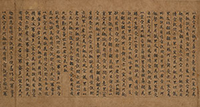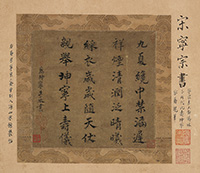The Art Museum recently launched an exhibition of 100 pieces of calligraphic works from the Tang to the Qing Dynasty from the Bei Shan Tang collection. The exhibition, entitled 'The Bei Shan Tang Legacy: Chinese Calligraphy', is open to the public until November and entry is free. Bei Shan Tang was the name of the private studio of the late Dr Lee Jung Sen, and the Bei Shan Tang collection contains an extensive assortment of Chinese art and antiquities. It is especially renowned for its outstanding examples of Chinese calligraphy and paintings, most of which have been contributed to the Art Museum at CUHK. To showcase the Bei Shan Tang collection to the public in a comprehensive manner, the Art Museum has planned a series of themed exhibitions, of which 'The Bei Shan Tang Legacy: Chinese Calligraphy', which was jointly organised with the Department of Fine Arts, is the first. The aim of the exhibition is to show visitors the aesthetics and culture of Chinese calligraphy. Chinese calligraphy possesses astounding beauty and a profound cultural legacy. Apart from the artistic skill and stylistic changes, these notable calligraphic works reflect the rise and fall of the dynasties, and the artist's personality, sensibility and, in some cases, social life. The exhibition, which is divided into two phases, features 100 pieces of calligraphic works from the Tang to the Qing Dynasty. The works include poems, letters, couplets, essays, manuscripts and Buddhist sutras. The highlights include the precious handwritings of the Chinese emperor, the exquisite works of esteemed calligraphers such as Ni Zan, Zhu Yunming, Wen Zhengming and Dong Qichang, and calligraphic works from Guangdong artists. The exhibition's diverse categories and styles give visitors a thorough picture of the aesthetic and cultural characteristics of Chinese calligraphy. Six selected pieces are displayed below. To complement the exhibition, the Art Museum and the Bei Shan Tang Foundation have also jointly provided an education gallery to arouse visitors' interests in and enhance their basic understanding of the art of Chinese calligraphy. A variety of public education programmes will also be launched, including a lecture series, guided tours, calligraphy workshops and demonstrations. For details, please visit http://www.cuhk.edu.hk/ics/amm/. The three-volume exhibition catalogue is now available. The catalogue, which includes eight essays and introduces the 100 exhibits in both Chinese and English, serves as an important reference for studying the Bei Shan Tang Collection and Chinese calligraphy. Details of the exhibition are as follows: | Exhibition Period : | Phase I: 12 April – 3 August 2014
Phase II: 11 August – 16 November 2014 | | Exhibition Venue : | Gallery II, III, IV, Art Museum, CUHK | | Opening Hours : | Mondays, Tuesdays, Wednesdays, Fridays and Saturdays 10:00 am – 5:00 pm
Sundays and Public Holidays 1:00 – 5:00 pm
Thursdays, New Year, Lunar New Year, Easter and Christmas Holidays Closed |
|


















